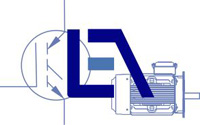Projects & Publications
Current Projects
Encoderless Initial Rotor Position Detection in Electrically Excited Synchronous Machines
Inverter fed electrically excited synchronous machines are used in high power applications from one to 20 megawatts. They are fed with medium voltage up to 10,000V and are mainly applied in pumps, conveyor systems or propulsion systems in marine applications.
For the control of such drives the information about the actual rotor or magnetic flux position is mandatory and is generally obtained by a mechanical encoder connected to the shaft. However, the drawbacks of such sensors are their sensitivity to dirty environment, to distorting electromagnetic fields and to mechanical shocks, resulting in the reduction of the total reliability of the whole drive system.
Today the control of the drive without mechanical sensor is possible by using modern approaches in which the rotor position is obtained based on the measured machine voltages and currents according to a complex mathematical model of the machine which is implemented in a digital computer equipped with a signal processor. If the machine rotates with a minimum velocity, these approaches work very reliably whereas they fail at low speeds in particular at standstill.
In order to allow the encoderless startup of the drive, different methods are necessary which are able to identify the rotor position at standstill. However, the methods utilized so far require special characteristics of the machine concerning the damper winding, excitation system etc. for the accurate identification of the rotor position. Thus, the encoderless control is until now only possible on few types of synchronous machines.
In this project a novel approach for the initial rotor position was developed. It is based on the injection of low frequency voltage pulses in the stator winding and the evaluation of the corresponding responses in the stator and field current. In contrast to the previous approaches, this method can be applied to a multitude of synchronous machines with different characteristics and thus allows the encoderless control in those machines where other approaches fail.
Publications
2016
S.Feuersänger amd M.Pacas
2015
Feuersänger, Simon; Pacas, Mario
2014
Feuersänger, Simon; Pacas, MarioInitial rotor position detection in synchronous machines using low frequency pulses, IECON 2014 - 40th Annual Conference of the IEEE Industrial Electronics Society, pp.675,681, Oct. 29 2014-Nov. 1 2014
2012
Feuersänger, Simon; Pacas, Mario
Feuersänger, Simon; Pacas, Mario
Initial Rotor Position Detection in Electrically Excited Medium Voltage Synchronous Machines. International PCIM Europe Conference May 2012. Nürnberg Germany
2011
Feuersänger, S.; Pacas, M.: Sensorless control with online parameter adaption for the PMSM, IEEE Industrial Electronics, IECON 2011, 37th Ann. Conference, Nov. 2011, Melbourne, Australia
Feuersänger, S.; Pacas, M.:
Online parameter tracking in PMSM-control schemes with and without encoder, International PCIM Europe Conference May 2011. Nürnberg Germany
